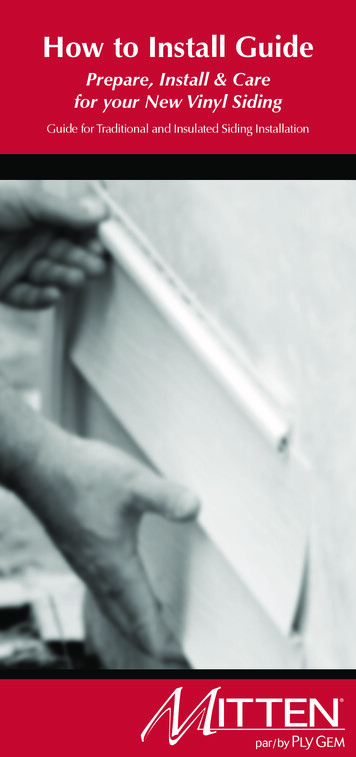
Transcription
How to Install GuidePrepare, Install & Carefor your New Vinyl SidingGuide for Traditional and Insulated Siding Installation1
Table of ContentsHow to MeasureBasic Installation GuidesBasic Installation Tools & EquipmentCutting the SidingFastener ChoicesPreparationNew ConstructionResidingFastening ProcedureHorizontal SidingObtaining Starting PointInstall Corner PostsStarter StripWindows, Doors and Roof LinesTrimFinish TrimDrip CapInstall Siding PanelsInstalling Siding Around Windows & DoorsFitting Siding around FixturesTop of Wall FinishTransition from Horizontal to VerticalVertical SidingInstall Horizontal FurringInstall Corner PostsInstalling around Windows & DoorsInstalling Siding panelsInstalling Vertical Siding on Gable EndsDetermine Roof AngleSoffit & FasciaVentilation RequirementsInstall Fascia CapExamine ConfigurationEnclosed OverhangsOpen RaftersMitered CornersFasciaSecuring Fascia Cap to Fascia BoardInstallation Guidelines for Foam Back CladdingOverlapping PanelsField OverlapsTips and Tricks for Foam Back InstallationInstalling in tight spots between windowsInstalling around fixturesCleaning saw and knife bladesHow to Keep your Siding Looking Like NewCleaning Agents 16161616171717181818192021222222222323
Vinyl SidingInstallation GuideThe key to successful vinyl siding application is in the planning.Proper installation is the best way to ensure your Mitten vinylsiding lives up to its reputation for quality.The method of applying vinyl siding and soffit is essentially thesame for new construction and residing projects. However,where required, special instructions for new constructionand residing are included. In all applications, care should beexercised to properly prepare the structure.It is recommended that installers review local building codesbefore starting a project of this nature.PostF-ChannelCrown MoldingPostJ-Channel(two options)How to MeasureAll houses can be broken down into shapes of rectangles ortriangles or a combination of both.The area to be sided can be determined by measuring the heightand width of the house including windows.Total all of the measurements for the areas to be sided. Windowsand doors are not usually deducted. Including them will providean allowance factor for waste. If the windows and doors areextremely large (such as garage or sliding glass doors), somedeductions can be made.For further assistance on estimating yoursiding and accessory needs, see ourMitten Online Vinyl Siding Estimating Calculatorat our website: mittenbp.com3
Basic Installation GuidelinesBefore getting started, it is important to review severalcommon rules for vinyl siding application. Vinyl siding,like all building materials, expands and contracts withtemperature changes. The amount of expansion andcontraction can be as much as 3/8 of an inch. This expansionand contraction must be accounted for in advance to preventthe siding from buckling which will mar the appearance ofyour home. The following rules, which come up throughoutthis guide, are critical for proper vinyl siding installation:1. Do not store siding in a location where temperaturesexceed 130 F or 54 C (i.e. On black top pavement duringunusually hot weather or under tarps or plastic wrap withoutair circulation.)2. Installed panels must move freely from side to side.3. When installing a siding panel, push up from the bottomuntil the lock is fully engaged with the piece below it. Donot force the panels up or down when fastening in position.Stretching the panel upward pulls the natural radius out ofthe panel and increases the friction of the locks.4. Always nail in the center of the slot. WARNING: Do notnail at the end of a slot! Doing so will cause the siding panelto be permanently damaged. If you must nail near the end ofa slot to hit a stud, etc., extend the length of the slot with anail slot punch tool.5. Do not drive the head of the nail tightly against thesiding nail hem. Allow 1/32” (about the thickness of a dime)clearance between the nail head and the siding panel. Drivenails straight and level to prevent distortion and buckling ofthe panel.6. Leave a minimum of 1/4” clearance at all openings andaccessory channel stops to allow for normal expansion andcontraction. When installing in temperatures below 40ºF,increase minimum clearance to 3/8”.7. Do not caulk the panels where they meet thereceiver of inside corner posts, outside corner posts, orJ-Channel. Do not caulk the overlap joints.8. Do not face-nail or staple through siding. Vinyl sidingexpands and contracts with outside temperature changes.Face-nailing can result in ripples in the siding.9. When residing, furring or removal of uneven originalsiding may be necessary.10. In new construction, avoid the use of green lumber asthe underlayment. Keep in mind that siding can only be asstraight and stable as what lies under it.4
Basic Installation Tools and EquipmentCommon hand tools, such as ahammer, fine-tooth saw, square,chalk line, level and tape measureare needed for proper installation.Safety glasses are recommendedfor eye protection. Other basictools include:Power SawA bench or radial-arm power saw canspeed the cutting of the siding. A finetooth blade (12 to 16 teeth per inch)should be used with the blade installedin the reverse direction.Utility KnifeVinyl is easy to cut, trim andscore with a utility knife orscoring tool.Utility KnifeTin SnipsGood quality tin snips orcompound aviation-type snipswill speed the cutting andshaping of the vinyl.Tin SnipsSnap Lock PunchA snap lock punch is used topunch lugs in the cut edges ofsiding to be used for the finishingcourse at the top of a wall, orunderneath a window.Snap lock punchNail Hole Slot PunchOccasionally, it may be necessaryto elongate a nail hem slot. Thehole is elongated to allow forexpansion and contraction.Nail hole slot punchUnlocking ToolRemove or replace a siding panelwith the unlocking tool. Insert thecurved end of the tool under theend of the panel and hook ontothe back lip of the butt lock. Todisengage the lock, pull down andslide the tool along the length ofthe panel. Use the same procedureto relock a panel.5Unlocking tool
Cutting the SidingWhen cutting vinyl siding, follow these guidelines:Safety goggles are always recommended forall cutting and nailing operations. As on anyconstruction job, use proper safety equipmentand follow safe construction practices.With a circular saw, install the fine-toothed(plywood) blade backwards on the saw fora smoother, cleaner cut, especially in coldweather. Cut slowly.Install bladebackwardsCAUTION! Use of a backwards blade onany other materials could be unsafe.With tin snips, avoid closing the bladescompletely at the end of a stroke for a neater,cleaner cut.With a utility knife or scoring tool, score thevinyl face up with medium pressure and snapit in half. It is not necessary to cut all the waythrough the vinyl.Fastener ChoicesUse aluminum, galvanized steel, or other corrosion-resistantnails, staples or screws when installing vinyl siding. Aluminumtrim pieces require aluminum or stainless steel fasteners. Allfasteners must be able to penetrate not less than 3/4” intoframing or furring.NailsNail heads should be 5/16”minimum in diameter. Shankshould be 1/8” in diameter.1/8"5/16" minimumScrewsScrews must be centered in the slot with a minimum 1/32” spacebetween the screw head and the vinyl. Screws must be able topenetrate not less than 3/4” into framing or furring and should be:Size #8, truss head or pan head, corrosion-resistant, self tappingsheet metal type.1/32"StaplesIf staples are being used instead of nails orscrews, they must: Not be less than 16 gauge semi-fattened to anelliptical cross-section Penetrate not less than 3/4” into framing orfurring Be wide enough in the crown to allow freemovement of the siding (1/32” away from thenailing hem).6
PreparationInspect and plan the job in advance. Check surfaces forstraightness and fur when necessary. Surfaces should beuniform and straight from various viewing angles.To achieve designed performance, vinyl siding must beinstalled over a weather resistant barrier system that includesa continuous weather resistant material and properlyintegrated flashing around all penetrations and where vinylsiding interfaces with other building products such as brick,stone, or stucco. Always consult the applicable buildingcode for minimum weather barrier requireme nts in yourarea. Keep in mind that additional measures may providebetter protection against water intrusion than the minimumrequirements of the building code.New ConstructionBe sure all nails and sheathing are in place. Waterproofsheathing paper is recommended under new construction or ifold siding is removed. Consult your local building code.3/4"3/4"3/4"astenerFastenerFastenerinyl ingFramingFastenerVinyl SidingVinyl SidingVinyl Sidinglywood or OSBheathinguction3/4"Wood LapSidingFan Fold(foam underlayment)Plywoodor OSBSheathingOriginalSheathingBlockFan FoldConcr(foam underlayment)Furring Strip(min. 3/4")OriginalSheathingWoodBlock orConcreteFramingResidingOverBlock or ConcreteNew ConstructionResidingResiding3/4"Nail down all looseboardsand replace any rotten ones.FastenerRemove shutters, downspouts,light fixtures, moldings andold caulking around doors andVinyl Sidingwindows. Vinyl siding MUST beapplied overa rigid sheathing thatWoodprovides aFramingsmooth flat surfacePlywood or OSBand provides sufficient thicknessSheathingto support the nail. The use ofLevelwall insulation will assist.New Construction73/4"FastenerVinyl SidingWood LapSidingWoodFramingFan Fold(foam underlayment)OriginalSheathingResidingO
Fastening ProcedureVinyl siding can expand and contract 1/2” or more over a 12’6”length with changes in temperature. Whether using nails, screws,or staples to fasten the siding, the following basic rules must befollowed: Make sure the panels are fullylocked along the length of thebottom, but do not force them up tightwhen fastening.do not pullup too tight Do not nail or staple through face ofsiding. This may result in ripples in thesiding. Do not drive the head of the fastenertightly against the siding nail hem. Leavea minimum of 1/32” (the thickness of adime) between the fastener head and thevinyl.NOYESNONOYESYESNONOYESYESNONOYESNO Tight nailing, screwing or stapling willcause the vinyl siding to buckle withchanges in temperature.YESYESNOYESNOYES When fastening, start in the center of theYESNO Center the fasteners in the slots to permitYESYESNONOpanel and work towards the ends.expansion and contraction of the siding. Drive fasteners straight and level toYESYESNOYESprevent distortion and buckling of thepanel. Start fastening vertical siding and cornerposts in the top of the upper most slotto hold them in position. Place allother fasteners in the center of the slots,spacing the fasteners a maximum of 16”apart for horizontal siding, every 12” forvertical siding and every 8” to 10” foraccessories.NONOYESYESNONOYESYES nailstartingNONOcorner posstarting nailstarting nailstarting nailstarting nailcorner poscorner pocorner postApplication for high wind areas.Using a 5/8” nylon washer with a 1/4”hole between the nail and siding, you canincrease the wind load capabilities of yoursiding installation.center nail withwashers in slotswallsheathingnails installedwith washers8corner pos
Horizontal SidingStep 1Obtaining Starting PointThe first step is to determine where you will apply the first courseof siding. This can be at the same level as the old siding or,on new construction, at a level that will cover the edge of thefoundation. Use a chalk line and a level to obtain a horizontalstarting point so that all installed siding will be perfectly level.At all corners, use a plumb line to ensure that corner posts arevertical.Follow these steps in the order shown for the easiest and bestapplication.Step 2Before the siding itself can be hung, a number of accessoriesmust be installed first. This includes starter strip, corner posts,window flashing, trim and J-Channel over the roof lines and atthe top of walls.1/4" space at top of wallInstall Corner PostsCut post to the length required allowing1/4” gap between the top of the postand the eaves or soffit. Begin nailing atthe top of the upper slot on both sidesof the corner post, hanging corner postin position. The balance of the nailingmust be in the center of the slots at 8” to12” on center. If more than one length isrequired, refer to the following note forcutting and overlapping instructions.8" - 16"Note Overlap the upper piece over the lower piece by cutting away 1” ofthe nailing flange on the top piece.Overlap 3/4”, allowing 1/4” forexpansion.This method will produce a visiblejoint between the two posts, butwill allow water to flow over thejoint, reducing the chance of waterinfiltration.1/4" forexpansionAll corner posts should be cut to appear the same and shouldextend 1/4” to 1/2” below first course of siding.9
Step 3Starter StripIn order for the siding to be installed in a level fashion, thestarter strip at the bottom of the wall must be level. With a tapemeasure, measure the width (w) of the starter strip.1/2"Determine, as explained inStep 1, where the bottom of the firstWcourse will begin. Measure up fromthis mark, the width of the starterstrip, less 1/2”, and chalk a level lineacross the wall.Using the chalk line as a guide,install the top edge of the starter strip alongthe bottom of the chalk line,nailing at 10” intervals.Keep the starter strip 1/4” from the nail hems of both the insideand outside corner posts. Leave 1/2” gap between ends ofadjacent starter strips to allow for expansion.Step 4Windows, Doors and Roof LinesWindow FlashingApply the flashing on the underside of thewindow first. Follow this application withflashing on the sides of the window. Makesure to overlap the bottom flashing. Theflashing should be long enough to directwater over the nail flange of the last courseof complete siding panels.OverlapflashingCut siding panel to fit window frameFinish TrimDrip CapJ-ChannelCut Siding Panel10
TrimJ-Channel trim or Window trim is used around windows anddoors to receive the siding. Using cuts 1and 2, follow the steps below when applying trim.1 Miter Cut Using Cut 1, bend the tabof the top piece of trimdown to provide flashingover the side trim.(Illustration A)2 Notch CutCut outwidth of trim Cut 1 can be used at theBend over toprovide flashingbottom end of the sidepiece of trim. Fold tabinward at the bottom ofthe window to preventwater from enteringunder the sill.(Illustration B)1Illustration A Cut the top trim longerthan the width of thewindow or door andnotch the channel at thetop using Cut 1. NotchCut 2 the side12211members and overlap topchannels. The trim shouldfit snug to the window.122112Illustration BFinish Trim111This2trim is used above1and below openings andat the2 top of walls adjoining 22soffits. Finish trim can befurred out to preserve the2 panel angle. Applypropera furring strip to the wall,butting it to the undersideof the windowsill. InstallJ-Channelthe finish trim, extendingit past either side of thewindow, as far as theouter edge of the J-Channelface. Finish trim is alsoused in an inverted position Furring Stripover the tops of the windowsand doors and where trimsbutt against window framing.Caulk where J and sill trimsmeet the opening frame.112Window orDoor FrameFinish TrimSiding Panel
Drip CapThe drip cap is nailed above the windowand door and extended on eitherside, flush with the exposed leg of theJ-Channel. A tab is cut at either end ofthe drip cap and bent down over theJ-Channels.Drip CapIf required to maintain panel angle, afurring strip is nailed over the dripcap.1"Step 5Trim back1/2"Install Siding PanelsFactory NotchThe first siding panel is engaged in thestarter strip and nailed. If the siding canbe moved laterally after it has beenlocked up, a positive lock has beenachieved. Continue nailing on 16”centers (and not over 8” centers in highwind areas). Leave 1/4” or 3/8” of spacewhere siding fits into accessories to allowfor expansion. When installing belowfreezing – leave 1/2”.1"OverlapOverlap the vinyl panels half the dimension of thefactory notch.For the best appearance, laps should be away from traffic areasand staggered horizontally a minimum of 2’ from one courseto the next. Do not “repeat” and overlap in on vertical line fora minimum of 3 courses. When overlapping do not nail closerthan 6” from the ends of both panels.No less than3 rows beforerepeating lapposition.Minimum 2'12
Installing Siding Around Windows and DoorsTo fit the siding under windows andmeasuredoors or under the eaves, measurethe distance from the bottom edgeof the lock on the finish trim to theSnap lock lugs5/8"bottom edge of the top lock of thelast full siding panel. Add 5/8" to thismeasurement to allow the panel edgeto engage in the finish trim. Cut the siding panel to the adjustedmeasurement under the windows orat finish of siding installation. Using the snap lock punch, punchears in the trimmed edge of thesiding panel at 8" intervals. Be surethe "ears" face outward from thewall. Lock the top edge of a siding panelin the finish trim and secure thelock at the lower edge of the panel.To fit the siding over the top ofwindows and doors, cut out the bottom section of the panelleaving 3/8" clearance on both sides of the window, so that thehorizontal edge of the cut-out fits firmly into the finish trim.Fitting Siding Around FixturesFor handling protrusions aroundthe wall, manufacturer’s accessoriesspecifically designed to fit aroundprotrusions can be installed or youcan cut siding panels to match theshape and contour of the obstruction.Always begin a new course of sidingat the fixture to avoid excess lap joints.Cut a slot 1/4” larger than the fixture.Step 6Top of Wall FinishSiding is measured and finished off at the top of the wallin exactly the same fashion as under a window or door, asexplained in installing siding around windows and doors,except that full sheets of siding will be used.To finish siding on gables, install a J-Channel along the gableangle against the soffit. Cut siding to the proper angle andinstall siding in the J-Channel, leaving a gap for expansion.13
Transition fromHorizontal to VerticalFinish the last course of horizontalsiding with the J-Channel and/orFinish trim. Install a drip cap and aJ-Channel (or H-Trim). The top pieceof J-Channel must have 1/4” weepholes drilled every 24” to allow forwater runoff.Vertical SidingJ-ChannelDrip CapFinish TrimHorizontal SidingVertical SidingPlan panel layout. Read steps 1 through 6 of HorizontalSiding Instructions for basic rules and tips of a standard sidingapplication.(3/4")Drill drainage holes every 12” inbottom edge of J-Channel.With vertical accessories andpanels, position the first nail at(1 1/2")the upper edge of the top nailingDrill holes fordrainage every 12"slot. This allows the panel to hang.Position the remaining nails in thecenter of the nailing slot.See fastening procedures on page 8.Step 1Install horizontal furring strips 12” oncenter or a solid nailable sheathing priorto installing the siding, if needed, to levelthe surface or provide sufficient materialfor 3/4” fastener penetration.Step 2Establish the vertical starting baseline. Install corner posts even withor slightly below the chalk lines.J-Channel should extend into cornerpost. (Remember to allow 1/4” forexpansion.)1/4" forexpansionStep 3Install J-Channel around windows anddoors and along eaves. The J-Channel atthe top of the opening should extend overside of J-Channel by 1/4”. Cut and bendthis top portion down over this side ofJ-Channel. (This will allow water to runoff.)14J-Channel
Step 4For ease of application, vertical installations should start at acorner. Fill the channel of theFurring Stripcorner by nailing down a stripof board 2” wide. Push a strip offinish trim into the channel of the Finish TrimSnap lock lugscorner over the board and nail.Cut off the locking leg of the firstpanel, and Snap-Lock Punch theedge at 12” intervals. Make surethe ‘ears’ face outward from theCorner PostVertical Sidingwall.Push the punched edge of thepanel into the strip of finish trim. Interlock and nail subsequentpanels. Measure and cut to size the last panel, punch the edgeand insert into the finish trim in the corner.Note: Before installing any siding, measure the width of the wallto ensure that the last panel will fit into finish trim in the corner.Installing Vertical Siding on Gable EndsFor a clean look, you want to have the groove of the verticalpanel centered in line with the peak of the gable. Start by trimming the perimeter of thegable with J-Channel, overlappingjoints. If horizontal siding is installedbelow vertical, see previous page forJ-Channelillustration.Sidewall At the peak of the gable, drop a chalkline perpendicular to the starterstrip. You can either start in thecenter using H-Trim and starterstrip each side or from corneracross. To ensure a balanced look,determine where to start the firstpanel. Measure from the chalk lineplumbalong the starter strip until you getlineto a point where the measurementto the J-Channel is less than a panelwidth. Mark that point with a pencil. Measure back toward the center of the gable from that point1¼", and draw a vertical line, parallel to the line dropped fromthe gable peak. This line is the position of the edge of the nailhem on the first panel.Verticalpanels15H-Trim withStarter stripeach sideJ-Channel
Determine Roof AngleEvery 3 panels, be sure to checkfor plumb and also measure to thecenter chalk line to ensure thatyou are going to arrive at the peakwith a center groove in line withit. Make needed small adjustmentsby pushing the panels "in" or "out"within the lock. The lock should faceaway from the general viewing area.Use a piece of siding,draw line here to reflectangle of roof onto sidingNote: Over roof lines install J-Channel to sit 1/2" off of shingles,not directly on the shingle surface. A piece of J-Channel can beused as a spacer template.Soffit and FasciaVentilation RequirementsProper attic ventilation is important for any home. Consult yourlocal building code or official for the appropriate requirementsfor your specific area and use vented soffit or other ventedproducts as necessary.Holds top of fascia.Specialty tool for fasciainstallations notcovered by gutter.Use where fascia canbe nailed to existingwood soffit.Finish TrimLock PunchFascia JFasciaStandard materialventilated soffits.Used in porch ceilings.Trim for edge of soffit.Uses: - open soffit- fascia without JJ-ChannelF-ChannelSoffit (Vented) Soffit (Solid)Use F-Channel forfastening at bottom.Step 1When installing soffit, the object is to provide two parallel slots,one on the house and one on the bottom of the Fascia board thatwill support the soffit panel. Depending on your truss and Fasciaboard configuration, there are several options for installation ofFascia cap and receiving channels for Soffit. Fascia cap with J orwithout J can be used with accessories such as J-Channel andF-Channel.16
Step 2The best approach is to select a method that works mosteffectively with the construction techniques used.Examine the illustrations and install the receiving channels in aconfiguration that closely resembles the construction techniquesin your project.Channels should be nailed every 12" to 16".Fascia capor coil stockOpen trussOpen rafterF-ChannelF-ChannelJ-ChannelSoffitSoffitUnder 24"Under 24"Step 3Enclosed OverhangsEnclosed OverhangPrevious Wood MouldingFor soffit applications withFurring Stripenclosed overhangs, start bySoffitinstalling 1/2" or 5/8"J-ChannelJ-Channel along wood fasciaDimension Aboard and on wall edge levelto bottom of Fascia board. NailJ-Channel every 8”-10”. Cut Soffit panels 1/4" shorter thandimension "A" and fit into place, locking panels together. Fastenwith nails.If you are removing existing wood soffit or molding, you mayneed to level area with a 1" x 2" furring strip.Step 4Open RaftersTo install soffit on an open rafteroverhang, F-Channel is attached tothe wall face and either F-Channelor Fascia with or without "J", isattached to fascia board. Soffit isthen cut to width of opening andsuspended between.For rafter widths greater than 24",we recommend a center fastenersupport should be provided.This can be provided by nailing2 x 4's from fascia to wall faceevery 3 rafters, then attaching a1 x 2 flat along bottom of thesesupport hangers. Soffit panels canbe screw-nailed into this support.Corners may be squared off ormitered.17Fascia capor coil stockOpen trussF-ChannelSoffitUnder 24"Add nailing stripsAdd framingSoffitJ-Channel24" or over
Step 5Mitered CornersInstall H-Trim or two J-Channels ondiagonal, then cut soffit panels to fitangle.For "best" appearance, cut miteredsoffit panels so that center v-groovesline up. Porch ceilings may becovered with non-ventilated soffitpanels. If ceiling is wider than 12',an H-Trim can be used to provide aseam.Squared-OffSquared-OffMitredMitredStep 6FasciaFascia boardFinish trimFinish Trim is installed around the topperimeter of the wood Fascia board.Measure the width of the face to thefinish trim and add 5/8" to insert intoFinish Trim.Overlap adjacent lengths of fascia byapproximately 1". To do this, cut awaya 1½" section from the bottom part ofthe underlying fascia. It is necessaryto nail through one end of each Fasciapanel so as to fix its position. Positionthe anchor nail as shown in thisdiagram so that the overlapping Fasciacap will cover the nail. Be sure to drilla 3/16" pilot hole for this nail.Soffit panelsVinyl fascia cap1"overlapnail1½”cut awayStep 7Securing Fascia cap to Fascia BoardIf you are installing Fascia without J, this is one of the rareinstances that face nailing is allowed. Drive the nail through the"U"-shaped groove in the soffit panel using small-headed nails.Once the soffit is face nailed to the Fascia cap, it will expandin one direction - toward the receiving channel opposite. Allowspace for expansion of soffit.Bend3"18
Installation Guidelines for Foam Back CladdingIt is important that foam back products be giventhe full tolerance available for expansion andcontraction. Follow these guidelines to ensurethe products will maintain a level and flat, "justinstalled" appearance for years to come. Please refer to the basic guidelines on page 4 as theyapply to foam back cladding installation as well. Mitten designed foam back cladding accessories mustbe used on all insulated installations. Do not nail or fit the panel tightly. When installing between outside corner and J-Channel,insert the panel in the corner post first, then open theface of the J-Channel and insert. The same steps arerequired between two J-Channels or an Inside Cornerand J-Channel. The 1-1/4" Finish Trim is used on the bottom ofwindows or at the top of the wall when the last courseis being installed. The foam is glued to within 1.5" to 1.75" of the end ofthe factory cut to allow the overlap to be tucked behindthe foam for a perfect lap. The foam must be butted tight to achieve maximumR-value. Make sure the panels slide freely whenengaged with the foam. Push up from the bottom until the lock is fully engagedwith the piece below it. Do not force panels up or down when fastening inposition. Stretching the panel upward pulls the natural radius outof the panel and increases the friction of the locks. Be sure to use SecureLock Insulated Starter strip asTMtraditional starter will not work.19
Overlapping Panels Factory notches should be used for all overlaps wherepossible. The foam is glued to within 1.5” to 1.75" of the end of thefactory cut to allow the overlap to be tucked behind the foamfor a perfect lap. Foam must be butted tight to achieve maximum R-value.Make sure the panels slide freely when engaged with thefoam. View Figures 2, 3, & 4.Figure 2 -- Use Factory Notches (Rear View)FOAMFOAMFigure 3 -- Butt Foam Tight (Rear View)FOAMFOAMFigure 4 -- Front View20
Field OverlapsIf you need to cut a “field” overlap you must:Figure 5 -- Field Overlapa) Trim and remove thefoam 1” back from thesiding end (Figure 5).2b) Clean the adhesive tracksusing a paint scraper to ensure aproper lap (Figure 6).Cut notches at top and bottomof the panel to mimic the factorynotches. (Figure 6).Figure 6 -- Field Overlap1”Remove all foamparticles andadhesive residueFigure 7 -- Field Overlapc) Slip the paint scraperbetween the foam andthe panel (Figure 7)approximately 2”, creatingan insert similar to thefactory joint illustrated in the‘Overlapping Panels’ section.2”Slip paint scraperbetween foam andpanel 2"d) Insert the panel as illustrated in the ‘Overlapping Panels’section making sure all free foam particles are removed so theywon’t get behind the panel and cause surface distortion. Makesure the panel slides freely once inserted behind the foam.21
Tips and Tricks for Foam Back InstallationInstalling in tight spots between windows Place a nail at the bottomof each of the two verticalJ-Channels between thewindows to hold them inplace. Leave the remaining nail slotsfree of nails for the moment.This allows the installer to flexthe J-Channels in order to slidethe next insulated panel intoplace. After each panel is installed,put another nail into theJ-Channels and repeat.After each panelis installed, addanother nail toJ-ChannelInstalling around pipe protrusions, etc. Begin a new panel at the fixture. Cut to match the shape of the fixture. Make the cut 1/4" larger than the fixture.NOTE: If available, use a commercially manufacturedtrim ring or fixture mount.Cleaning Saw and Knife Blades Use mineral spirits to wipe your blades clean as theybegin to accumulate adhesive residue or vinyl particles. At the end of the day, remove the saw blade from thecircular saw and allow it to soak for a short time in thi
Vinyl Siding Installation Guide The key to successful vinyl siding application is in the planning. Proper installation is the best way to ensure your Mitten vinyl siding lives up to its reputation for quality. The method of applying vinyl siding and soffit is essentially the same for new construction and residing projects. However,










